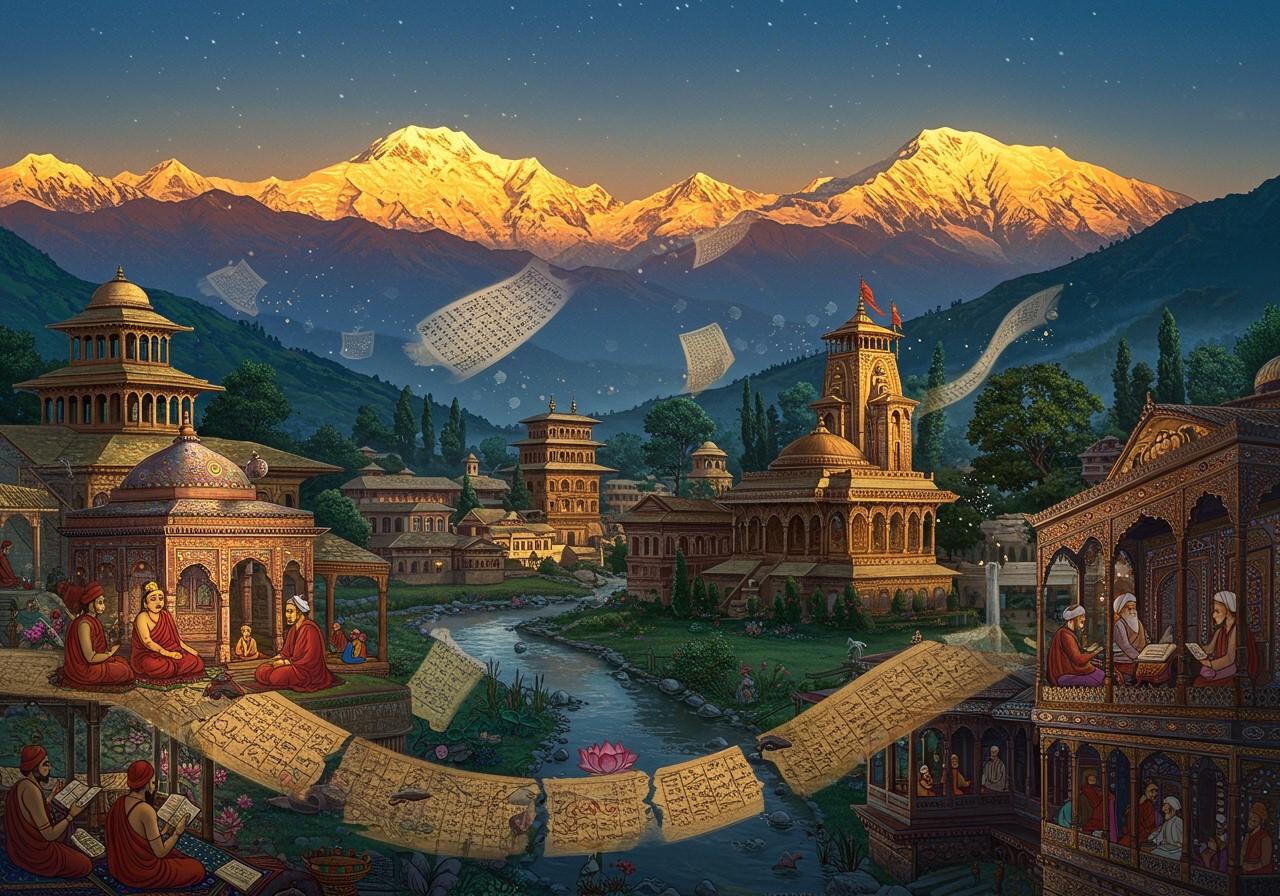
Kashmir’s history is a captivating narrative woven with vibrant traditions and intriguing tales. The name “Kashmir” is believed to mean “desiccated land” in Sanskrit. Kalhana’s 12th-century chronicle, the Rajatarangini, serves as a cornerstone for understanding the region’s early Hindu kings and the significant cultural shifts of the time. The Rajatarangini portrays Kashmir as a former lake, drained by the sage Kashyapa, and delves into the area’s religious diversity, including the rise of Buddhism and Shaivism. This influential text has significantly impacted Indian historiography, influencing literature, culture, and political discourse within the region and beyond.
However, Kashmir’s story extends far beyond Kalhana’s account. Other historical chronicles offer a broader and deeper understanding of this region’s rich heritage. Let’s delve into some of these lesser-known texts.
Jonaraja’s Rajatarangini (15th Century)
Jonaraja extended Kalhana’s work, providing valuable insights into the socio-political transformations of Kashmir. His focus on the reigns of both later Hindu and early Muslim rulers offers a unique perspective on this pivotal period. He documented the impact of these rulers on the region.
- Narrative Style: Departing from Kalhana’s approach, Jonaraja emphasized political and religious dynamics, reflecting the changing landscape of his time. His narrative provides a nuanced view of the power structures and religious influences at play.
- Historical Context: Writing during a period of significant change, Jonaraja highlighted key events such as the introduction of Islam to Kashmir. This offers valuable context for understanding the cultural shifts that shaped the region.
Jonaraja’s chronicle serves as a bridge between ancient and medieval Kashmir, illustrating the impact of new cultural influences on the region’s development.
Srivara Rajatarangini (16th Century)
Srivara continued the historical narrative, focusing on the transitions of the late medieval period, particularly during the Sultanate era.
- Contributions: Srivara’s work highlights the political and cultural shifts that occurred under Sultan Zain-ul-Abidin’s rule, offering a deeper understanding of this era. He meticulously documented the transformations in governance and cultural practices.
- Challenges and Cultural Shifts: Writing amidst significant change, Srivara faced the challenge of maintaining historical continuity. His work provides a crucial record of the complex Hindu-Muslim interactions during this period, preserving the narrative of Kashmir’s diverse heritage. He carefully documented the evolving relationship between different religious communities.
Srivara’s chronicle is essential for comprehending the intricate cultural dynamics of his time.
Later Continuations of Rajatarangini
Other authors, including Prajyabhatta and Suka, added their unique perspectives to the historical narrative of Kashmir. These later chronicles cover various periods, enriching our understanding of the region’s complex past.
- Unique Perspectives and Challenges: Each author brought distinct insights into the evolving political landscape of Kashmir. They also faced the challenge of maintaining historical accuracy and continuity amidst ongoing political changes and upheavals. Their diverse viewpoints provide a richer understanding of the historical narrative.
- Historical Importance: These works are invaluable resources for historians, offering different perspectives and filling gaps in the historical record. They contribute to a more complete picture of Kashmir’s intricate history.
Exploring these texts provides a more comprehensive understanding of Kashmir’s history, moving beyond Kalhana’s foundational narrative.
Poojn.in: Connecting You to Kashmir’s Sacred Heritage
Poojn.in, India’s leading online store for cultural goods and services, helps you connect with Kashmir’s rich spiritual legacy through a wide selection of authentic puja items and ritual materials. Many traditional practices mentioned in the historical chronicles continue to this day, and Poojn.in provides the resources to support these traditions.
We offer a variety of items essential for Kashmiri-style pujas and rituals:
- Pure copper and brass items traditionally used in Kashmiri ceremonies
- Authentic kumkum and other ritual materials sourced according to traditional standards
- Specially curated puja thalis that align with Kashmiri customs
- Traditional bell-metal items used in Kashmir temple traditions
For those seeking to maintain Kashmiri ritual traditions, Poojn.in offers:
- Gangajal in copper vessels
- Pure cotton wicks for traditional deepams
- Handcrafted puja items made by skilled artisans
Visit www.poojn.in to explore our complete collection. We offer convenient doorstep delivery across India.
Embracing the Tapestry of Kashmir’s Past
Kashmir’s history is a vibrant tapestry woven with the threads of narratives from Kalhana, Jonaraja, Srivara, and many others. Each thread represents a unique era, contributing to the rich cultural and religious heritage of this captivating region. By venturing beyond Kalhana’s Rajatarangini, we uncover the diverse narratives that have shaped Kashmir’s identity.
These chronicles offer a glimpse into the lives, beliefs, and transformations that have defined Kashmir through the ages. They serve as a testament to the resilience and richness of the region’s heritage. By embracing these histories, we gain a deeper understanding of Kashmir’s vibrant legacy, connecting us to its past and guiding us into the future.
To learn more about the Shankaracharya Temple in Srinagar, Kashmir, which embodies this rich history, visit these related posts:
- Shankaracharya Temple: Spiritual Heart of Kashmir – A Deep Dive
- Shankaracharya Temple Visit: Planning Your Trip, Timings, Accessibility & More
- Shankaracharya Temple: Architecture, History, and Spirituality


